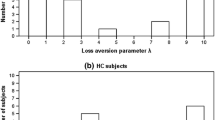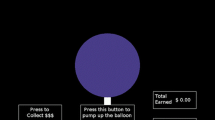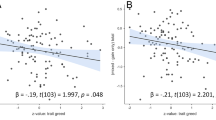Abstract
A group of pathological gamblers and a group of problem gamblers (i.e., gamblers at risk of becoming pathological) were compared to healthy controls on their risk-taking propensity after prior losses. Each participant played both the Balloon Analogue Risk Taking task (BART) and a modified version of the same task, where individuals face five repeated predetermined early losses at the onset of the game. No significant difference in risk-taking was found between groups on the standard BART task, while significant differences emerged when comparing behaviors in the two tasks: both pathological gamblers and controls reduced their risk-taking tendency after prior losses in the modified BART compared to the standard BART, whereas problem gamblers showed no reduction in risk-taking after prior losses. We interpret these results as a sign of a reduced sensitivity to negative feedback in problem gamblers which might contribute to explain their loss-chasing tendency.

Similar content being viewed by others
References
American Psychiatric Association. (2013). Diagnostic and statistical manual of mental disorders (5th ed) (DSM-5). Diagnostic and statistical manual of mental disorders (4th ed.) TR., 280. doi:10.1176/appi.books.9780890425596.744053.
APA. (1994). Diagnostic and statistical manual of mental disorders (4th ed., pp. 69–81). Washington: APA.
Barratt, E. (1959). Anxiety and impulsiveness related to psychomotor efficiency. Perceptual and Motor Skills, 9(3), 191–198. doi:10.2466/pms.1959.9.3.191.
Bechara, A., Damasio, A. R., Damasio, H., & Anderson, S. W. (1994). Insensitivity to future consequences following damage to human prefrontal cortex. Cognition, 50(1–3), 7–15. doi:10.1016/0010-0277(94)90018-3.
Benjamin, A. M., & Robbins, S. J. (2007). The role of framing effects in performance on the Balloon Analogue Risk Task (BART). Personality and Individual Differences, 43(2), 221–230. doi:10.1016/j.paid.2006.11.026.
Bibby, P. A. (2016). Loss-chasing, alexithymia, and impulsivity in a gambling task: Alexithymia as a precursor to loss-chasing behavior when gambling. Frontiers in Psychology, 7(3), 1–13. doi:10.3389/fpsyg.2016.00003.
Brevers, D., He, Q., Xue, G., & Bechara, A. (2017). Neural correlates of the impact of prior outcomes on subsequent monetary decision-making in frequent poker players. Biological Psychology, 124, 30–38. doi:10.1016/j.biopsycho.2017.01.009.
Cazzell, M., Li, L., Lin, Z. J., Patel, S. J., & Liu, H. (2012). Comparison of neural correlates of risk decision making between genders: An exploratory fNIRS study of the Balloon Analogue Risk Task (BART). NeuroImage, 62(3), 1896–1911. doi:10.1016/j.neuroimage.2012.05.030.
Ciccarelli, M., Griffiths, M. D., Nigro, G., & Cosenza, M. (2017). Decision making, cognitive distortions and emotional distress: A comparison between pathological gamblers and healthy controls. Journal of Behavior Therapy and Experimental Psychiatry, 54, 204–210. doi:10.1016/j.jbtep.2016.08.012.
Cosenza, M., Griffiths, M. D., Nigro, G., & Ciccarelli, M. (2017). Risk-taking, delay discounting, and time perspective in adolescent gamblers: An experimental study. Journal of Gambling Studies, 33(2), 383–395. doi:10.1007/s10899-016-9623-9.
Damasio, A. R. (1994). Descartes’ error: Emotion, rationality and the human brain (p. 352). New York: Putnam.
de Ruiter, M. B., Veltman, D. J., Goudriaan, A. E., Oosterlaan, J., Sjoerds, Z., & van den Brink, W. (2009). Response perseveration and ventral prefrontal sensitivity to reward and punishment in male problem gamblers and smokers. Neuropsychopharmacology : Official Publication of the American College of Neuropsychopharmacology, 34(4), 1027–1038. doi:10.1038/npp.2008.175;10.1038/npp.2008.175.
Dickerson, M., Hinchy, J., & Fabre, J. (1987). Chasing, arousal and sensation seeking in off-course gamblers. British Journal of Addiction, 82(6), 673–680. doi:10.1111/j.1360-0443.1987.tb01530.x.
Figner, B., Mackinlay, R. J., Wilkening, F., & Weber, E. U. (2009). Affective and deliberative processes in risky choice: age differences in risk taking in the Columbia Card Task. Journal of Experimental Psychology. Learning, Memory, and Cognition, 35(3), 709–730. doi:10.1037/a0014983.
Franken, I. H. A., Georgieva, I., Muris, P., & Dijksterhuis, A. (2006). The rich get richer and the poor get poorer: On risk aversion in behavioral decision-making. Judgment and Decision Making, 1(2), 153–158.
Giorgetta, C., Grecucci, A., Rattin, A., Guerreschi, C., Sanfey, A. G., & Bonini, N. (2014). To play or not to play: A personal dilemma in pathological gambling. Psychiatry Research, 219(3), 562–569. doi:10.1016/j.psychres.2014.06.042.
Giorgetta, C., Grecucci, A., Zuanon, S., Perini, L., Balestrieri, M., Bonini, N., et al. (2012). Reduced risk-taking behavior as a trait feature of anxiety. Emotion, 12(6), 1373–1383. doi:10.1037/a0029119.
Goodman, W. K., Price, L. H., Rasmussen, S. A., Mazure, C., Fleischmann, R. L., Hill, C. L., et al. (1989). The Yale-Brown obsessive compulsive scale. I. Development, use, and reliability. Archives of General Psychiatry, 46(11), 1006–1011. doi:10.1001/archpsyc.1989.01810110048007.
Grant, J. E., Potenza, M. N., Weinstein, A., & Gorelick, D. A. (2010). Introduction to behavioral addictions. American Journal of Drug and Alcohol Abuse, 36(5), 233–241. doi:10.3109/00952990.2010.491884.
Grecucci, A., Giorgetta, C., Rattin, A., Guerreschi, C., Sanfey, A. G., & Bonini, N. (2014). Time devours things: How impulsivity and time affect temporal decisions in pathological gamblers. PLoS ONE, 9(10), e109197. doi:10.1371/journal.pone.0109197.
Hershey, J. C., & Schoemaker, P. J. H. (1980). Risk taking and problem context in the domain of losses: An expected utility analysis. The Journal of Risk and Insurance, 47(1), 111–132. doi:10.2307/252685.
Holt, C. A., & Laury, S. K. (2002). Risk aversion and incentive effects. American Economic Review, 92(5), 1644–1655. doi:10.1257/000282802762024700.
Hunt, M. K., Hopko, D. R., Bare, R., Lejuez, C. W., & Robinson, E. V. (2005). Construct validity of the Balloon Analog Risk Task (BART): Associations with psychopathy and impulsivity. Assessment, 12(4), 416–428. doi:10.1177/1073191105278740.
Krmpotich, T., Mikulich-Gilbertson, S., Sakai, J., Thompson, L., Banich, M. T., & Tanabe, J. (2015). Impaired decision-making, higher impulsivity, and drug severity in substance dependence and pathological gambling. Journal of Addiction Medicine, 9(4), 273–280. doi:10.1097/ADM.0000000000000129.
Lauriola, M., Panno, A., Levin, I. P., & Lejuez, C. W. (2014). Individual differences in risky decision making : A meta-analysis of sensation seeking and impulsivity with the Balloon Analogue Risk Task. Journal of Behavioral Decision Making, 36(April 2013), 20–36. doi:10.1002/bdm.
Ledgerwood, D. M., Alessi, S. M., Phoenix, N., & Petry, N. M. (2009). Behavioral assessment of impulsivity in pathological gamblers with and without substance use disorder histories versus healthy controls. Drug and Alcohol Dependence, 105(1–2), 89–96. doi:10.1016/j.drugalcdep.2009.06.011.
Leigh, B. C. (1999). Peril, chance, adventure: concepts of risk, alcohol use and risky behavior in young adults. Addiction, 94(3), 371–383. doi:10.1046/j.1360-0443.1999.9433717.x.
Lejuez, C. W., Aklin, W., Daughters, S., Zvolensky, M., Kahler, C., & Gwadz, M. (2007). Reliability and validity of the youth version of the Balloon Analogue Risk Task (BART-Y) in the assessment of risk-taking behavior among inner-city adolescents. Journal of Clinical Child and Adolescent Psychology, 36(1), 106–111. doi:10.1080/15374410709336573.
Lejuez, C. W., Aklin, W. M., Jones, H. A., Richards, J. B., Strong, D. R., Kahler, C. W., et al. (2003). The Balloon Analogue Risk Task (BART) differentiates smokers and nonsmokers. Experimental and Clinical Psychopharmacology, 11(1), 26–33. doi:10.1037/1064-1297.11.1.26.
Lejuez, C. W., Read, J. P., Kahler, C. W., Richards, J. B., Ramsey, S. E., Stuart, G. L., et al. (2002). Evaluation of a behavioral measure of risk taking: The Balloon Analogue Risk Task (BART). Journal of Experimental Psychology: Applied, 8(2), 75–84. doi:10.1037//1076-898X.8.2.75.
Lesieur, H. R. (1979). The compulsive gambler’s spiral of options and involvement. Psychiatry, 42(1), 79–87. doi:10.1521/00332747.1979.11024008.
Lesieur, H. R., & Blume, S. B. (1987). The South Oaks Gambling Screen (SOGS): A new instrument for the identification of Pathological gamblers. American Journal of Psychiatry, 144(9), 1184–1188. doi:10.1176/ajp.144.9.1184.
Linnet, J., Røjskjær, S., Nygaard, J., & Maher, B. A. (2006). Episodic chasing in pathological gamblers using the Iowa gambling task. Scandinavian Journal of Psychology, 47(1), 43–49. doi:10.1111/j.1467-9450.2006.00491.x.
Lole, L., Gonsalvez, C. J., & Barry, R. J. (2015). Reward and punishment hyposensitivity in problem gamblers: A study of event-related potentials using a principal components analysis. Clinical Neurophysiology, 126(7), 1295–1309. doi:10.1016/j.clinph.2014.10.011.
Losecaat Vermeer, A. B., Boksem, M. A. S., & Sanfey, A. G. (2014). Neural mechanisms underlying context-dependent shifts in risk preferences. NeuroImage, 103, 355–363. doi:10.1016/j.neuroimage.2014.09.054.
Lynam, D. R., Smith, G. T., Whiteside, S. P., & Cyders, M. A. (2006). The UPPS-P: Assessing five personality pathways to impulsive behavior. West Lafayette, IN: Purdue University.
MacKillop, J., Amlung, M. T., Few, L. R., Ray, L. A., Sweet, L. H., & Munafò, M. R. (2011). Delayed reward discounting and addictive behavior: A meta-analysis. Psychopharmacology, 216(3), 305–321. doi:10.1007/s00213-011-2229-0.
O’Connor, J., & Dickerson, M. (2003). Impaired control over gambling in gaming machine and off-course gamblers. Addiction, 98(1), 53–60. doi:10.1046/j.1360-0443.2003.00232.x.
Pallanti, S., DeCaria, C. M., Grant, J. E., Urpe, M., & Hollander, E. (2005). Reliability and validity of the pathological gambling adaptation of the Yale-Brown Obsessive-Compulsive Scale (PG-YBOCS). Journal of Gambling Studies, 21(4), 431–443. doi:10.1007/s10899-005-5557-3.
Patton, J. H., Stanford, M. S., & Barratt, E. S. (1995). Factor structure of the barratt impulsiveness scale. Journal of Clinical Psychology, 51(6), 768–774. doi:10.1002/1097-4679(199511)51:6<768:AID-JCLP2270510607>3.0.CO;2-1.
Pleskac, T. J., Wallsten, T. S., Wang, P., & Lejuez, C. W. (2008). Development of an automatic response mode to improve the clinical utility of sequential risk-taking tasks. Experimental and Clinical Psychopharmacology, 16(6), 555–564. doi:10.1037/a0014245.
Reuter, J., Raedler, T., Rose, M., Hand, I., Gläscher, J., & Büchel, C. (2005). Pathological gambling is linked to reduced activation of the mesolimbic reward system. Nature Neuroscience, 8(2), 147–148. doi:10.1038/nn1378.
Robbins, T. W., & Clark, L. (2015). Behavioral addictions. Current Opinion in Neurobiology, 30(February), 66–72.
Rosi, A., Cavallini, E., Gamboz, N., & Russo, R. (2016). On the generality of the effect of experiencing prior gains and losses on the Iowa Gambling Task: A study on young and old adults. Judgment and Decision Making, 11(2), 185–196.
Schellinck, T., & Schrans, T. (1998). The 1998 Nova Scotia video lottery survey. Canada: Halifax.
Skinner, B. F. (1984). Selection by consequences. Behavioral and Brain Sciences, 7(4), 477–481. doi:10.1017/S0140525X0002673X.
Slovic, P., Finucane, M. L., Peters, E. M., & MacGregor, D. G. (2007). The affect heuristic. European Journal of Operational Research, 177(3), 1333–1352.
Stinchfield, R. (2002). Reliability, validity, and classification accuracy of the South Oaks Gambling Screen (SOGS). Addictive Behaviors, 27(1), 1–19. doi:10.1016/S0306-4603(00)00158-1.
Tanabe, J., Thompson, L., Claus, E., Dalwani, M., Hutchison, K., & Banich, M. T. (2007). Prefrontal cortex activity is reduced in gambling and nongambling substance users during decision-making. Human Brain Mapping, 28(12), 1276–1286. doi:10.1002/hbm.20344.
Thaler, R. H., & Johnson, E. J. (1990). Gambling with the house money and trying to break even: The effects of prior outcomes on risky choice. Management Science, 36(6), 643–660. doi:10.1287/mnsc.36.6.643.
Thorndike, E. L. (1898). Animal intelligence: An experimental study of the associative processes in animals. Psychological Review, 5(5), 551–553. doi:10.1037/h0067373.
Toce-Gerstein, M., Gerstein, D. R., & Volberg, R. A. (2003). A hierarchy of gambling disorders in the community. Addiction, 98(12), 1661–1672. doi:10.1111/j.1360-0443.2003.00545.x.
Vermeer, A. B. L., & Sanfey, A. G. (2015). The effect of positive and negative feedback on risk-taking across different contexts. PLoS ONE, 10(9), e0139010. doi:10.1371/journal.pone.0139010.
Walker, M. B., & Dickerson, M. G. (1996). The prevalence of problem and pathological gambling: A critical analysis. Journal of Gambling Studies, 12(2), 233–249. doi:10.1007/BF01539176.
Weber, M., & Zuchel, H. (2005). How do prior outcomes affect risk attitude? Comparing escalation of commitment and the house-money effect. Decision Analysis, 2(1), 30–43. doi:10.1287/deca.1050.0034.
White, T. L., Lejuez, C. W., & de Wit, H. (2008). Test-retest characteristics of the Balloon Analogue Risk Task (BART). Experimental and Clinical Psychopharmacology, 16(6), 565–570. doi:10.1037/a0014083.
Whiteside, S. P., & Lynam, D. R. (2001). The five factor model and impulsivity: Using a structural model of personality to understand impulsivity. Personality and Individual Differences, 30(4), 669–689. doi:10.1016/S0191-8869(00)00064-7.
World Health Organization. (1993). The ICD-10 classification of mental and behavioural disorders: Diagnostic criteria for research. Geneva: World Health Organization.
Xue, G., Lu, Z., Levin, I. P., & Bechara, A. (2010). The impact of prior risk experiences on subsequent risky decision-making: The role of the insula. NeuroImage, 50(2), 709–716. doi:10.1016/j.neuroimage.2009.12.097.
Xue, G., Lu, Z., Levin, I. P., & Bechara, A. (2011). An fMRI study of risk-taking following wins and losses: Implications for the gambler’s fallacy. Human Brain Mapping, 32(2), 271–281. doi:10.1002/hbm.21015.
Funding
This study was funded by the Autonomous Province of Trento (PAT) (“Pre.GIO.—Monitoraggio e prevenzione del gioco d’azzardo patologico in Trentino”, Atto esecutivo 2013, Area di ricerca 1—Rapporti sulla sicurezza in Trentino—Linea di attività 2). This experiment (Nicolao Bonini, P.I.) was part of that more extensive research project.
Author information
Authors and Affiliations
Corresponding authors
Ethics declarations
Conflict of interest
Nicolao Bonini declares that he has no conflict of interest. Alessandro Grecucci declares that he has no conflict of interest. Manuel Nicolè declares that he has no conflict of interest. Lucia Savadori declares that she has no conflict of interest.
Ethical Approval
All procedures performed in studies involving human participants were in accordance with the ethical standards of the institutional research committee and with the 1964 Helsinki declaration and its later amendments or comparable ethical standards.
Rights and permissions
About this article
Cite this article
Bonini, N., Grecucci, A., Nicolè, M. et al. Reduced Risk-Taking After Prior Losses in Pathological Gamblers Under Treatment and Healthy Control Group but not in Problem Gamblers. J Gambl Stud 34, 429–447 (2018). https://doi.org/10.1007/s10899-017-9709-z
Published:
Issue Date:
DOI: https://doi.org/10.1007/s10899-017-9709-z




